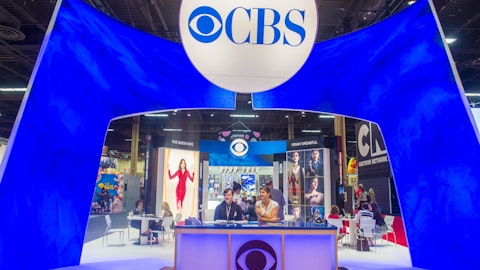Sinclair Broadcast Group, Inc. (NASDAQ:SBGI) Q3 2023 Earnings Call Transcript November 1, 2023
Operator: Good day, everyone, and welcome to Sinclair Third Quarter 2023 Earnings Conference Call. [Operator Instructions] It is now my pleasure to turn the floor over to your host, Chris King, Vice President of Investor Relations. Sir, the floor is yours.
Chris King : Thank you. Good afternoon, everyone, and thank you for joining Sinclair’s Third Quarter 2023 Earnings Conference Call. Joining me on the call today are Chris Ripley, our President and Chief Executive Officer; Lucy Rutishauser, our Executive Vice President and Chief Financial Officer; and Rob Weisbord, our Chief Operating Officer and President of Local Media. Before we begin, I want to remind everyone that slides and supplemental information for today’s earnings call are available on our website, sbgi.net, on the Investor Information page and on the earnings webcast page. Certain matters discussed on this call may include forward-looking statements regarding, among other things, future operating results. Such statements are subject to a number of risks and uncertainties.
Actual results in the future could differ from those described in the forward-looking statements as a result of various important factors. Such factors have been set forth in the company’s most recent reports as filed with the SEC and included in our third quarter earnings release. The company undertakes no obligation to update these forward-looking statements. The company uses its website as a key source of company information, which can be accessed at www.sbgi.net. In accordance with Regulation FD, this call is being made available to the public. A webcast replay will be available on our website and will remain available until our next quarterly earnings release. Included on the call will be a discussion of non-GAAP financial measures, specifically adjusted EBITDA, adjusted free cash flow and leverage.
The company considers adjusted EBITDA to be an indicator of the company’s operating performance and the ability to service its debt. The company also believes that adjusted EBITDA is frequently used by industry analysts, investors and lenders as a measure of valuation and ability to service debt. The company also discloses segment adjusted EBITDA as an indicator of the operating performance of its segments in accordance with ASC 280 segment reporting. The company considers adjusted free cash flow to be an indicator of the company’s operating performance. The company also believes that free cash flow is a commonly used to measure of valuation for companies in the local media industry. In addition, this measure is frequently used by industry analysts, investors and lenders as a measure of valuation for local media companies.
These measures are not formulated in accordance with GAAP are not meant to replace GAAP measurements and may differ from other companies’ uses or formulations. The company does not provide reconciliations on a forward-looking basis. Further discussions and reconciliations of the company’s non-GAAP financial measures to comparable GAAP financial measures can be found on our website, www.sbgi.net. Any discussion of pro forma numbers as compared to 2022 will exclude Diamond, which was deconsolidated March 1, 2022 and any business sold since the beginning of 2022. For actual results, including the periods that Diamond was consolidated, please refer to this afternoon’s earnings release. In addition, due to the pending Diamond litigation, we are unable to comment on any specifics regarding the legal issues surrounding Diamond’s bankruptcy or any potential financial impact that may or may not occur as a result of those matters other than to say that Sinclair firmly believes it has meritorious defenses to the allegations in the Diamond lawsuit, and we plan to vigorously defend against them.
Let me now turn the call over to Chris Ripley.
Christopher Ripley : Good afternoon, and thank you for joining us. I’ll start on Slide 4 by introducing an overview of our third quarter financial results. As you can see, Sinclair delivered strong third quarter results that met or exceeded our guidance expectations across the board on both advertising and distribution revenues as well as media expenses in both our Local Media and Tennis Channel segments. As a result, we exceeded the midpoint of our adjusted EBITDA guidance for the quarter by 40%, and we also exceeded adjusted free cash flow guidance. Turning to Slide 5. We have repurchased over $64 million in face value of our debt since the beginning of June. On average, the repurchases were made at a 24% discount to par for a total cash outlay of just over $49 million, representing a yield to maturity of 13%.
These open market debt repurchases, which took place across all 3 tranches of our notes as well as our nearest dated maturity our 2026 term loan represents our priority to strengthen our balance sheet while acting opportunistically when market conditions permit. Turning to Slide 6. As we’ve stated in the past, we are committed to our traditional local media business with the realization that the industry needs to transform in the coming years due to subscriber churn and regulatory constraints. With that being said, we believe Sinclair as well as the broader industry has multiple growth drivers in the coming quarters. First, we expect to see record-breaking political advertising revenue in 2024. We are seeing current political revenues trend above both 2021 and 2019 levels so far this year, and we expect the strong growth of issue-oriented political advertising and what appears to be several close Senate and core in-house races in our footprint will accelerate this growth significantly as we get closer to next year’s election.
Second, our focus on high demand and differentiated local news and sports content as well as syndicated programming continues to drive strong and loyal viewership, with 43% of viewer impressions across our station portfolio driven by non-network content. In addition, with nearly all of our big 4 traditional subscribers renewing by the end of next year, we continue to expect a 3-year positive low single-digit CAGR of net retrans revenues through our negotiation cycle from 2022 through 2025. And while the regulatory environment is far from positive overall for broadcasters, particularly from a relative perspective to our big tech and big media competitors, we are cautiously optimistic regarding long-term changes for a couple of industry items.
Turning to Slide 7. All of these developments in addition to significant changes within the past several weeks in the pay-TV distribution model, we believe could begin to launch what I like to refer to as the great rebundling. We believe the recent Charter-Disney carriage agreement has the potential to materially strengthen the Pay TV bundle in the future. While we don’t know all the details regarding the new agreement, what we do know is it appears to significantly increase the consumer value proposition of pay-TV relative to a la carte D2C offerings. It will incorporate certain DC — Disney DTC platforms, including Disney+ and ESPN+ into Charter’s current pay-TV packages. In addition, the agreement allows Charter to drop some of Disney’s lower-rated undifferentiated cable channels from its bundles.
We believe these developments reduce consumer reasons to leave traditional pay-TV bundles and increased consumers’ overall value received, which should lead to meaningful churn reduction of pay-TV subscribers over time. In addition, the pay-TV bundle is crucially important to our television network partners as well. Each network receives approximately $1 billion annually in reverse compensation from station groups as well as significant advertising and reach benefits. The bottom line being that it is doubtful that networks are financially viable today without those revenue streams and other benefits. And not only is the bundle important to the networks, but it’s also important to the various sports leagues that want to maximize both revenue and distribution of their content.
The NFL is the most obvious example of this decision-making and they, as a league, have benefited tremendously from the nationwide distribution on over-the-air channels. Add all these points up, and it’s our view that the relative value of the pay-TV bundle as compared to a la carte DTC offerings remain strong and is, in fact, improving as the environment continues to shift in favor of the pay-TV bundle. We look forward to continuing having discussions with our network and distribution partners as to how we can add content and other value to consumers to attract more subscribers back to the value of the bundle. Now let me turn it over to Rob to discuss our local media strategy.
Robert Weisbord : Thanks, Chris. Turning to Slide 8. I wanted to touch on our four strategic pillars of local media and the transformation that we are on our way to execute it. First is multi-platform content. To generate revenues, we need impressions. And to increase impressions, we need to be a multi-platform media content provider. The days of reaching eyeballs only through linear TV transmission are gone. Our stations have active presence on every platform, including linear and various social media applications, YouTube, station websites, podcast everywhere our viewers and listeners are and every platform that can carry our content is where we need to be. We are constantly working on maximizing impressions and the best way to do that is to be on multiple platforms.
This leads to our second pillar, community and interactive engagement. We not only capture impressions, but we monetize that. We accomplished this by keeping our viewers on our platform for longer periods of time through various methods of engagement. We are developing opportunities for the viewers to further engage with us and for us to develop more unique viewers and consumers of our content as well as more revenue opportunities per user. These methods may include unique content, a game center or running various contests just to name a few, which brings us to the third pillar of marketing services. We continue to refine our services, including introducing a unified ad sales platform in recent months, which ties together our ad proposals for linear, digital, as well as billing, traffic for digital and order entry systems, which provide massive efficiency improvements for our sales teams.
It makes the digital multiplatform sale dramatically easier to execute upon. We are also using AI to increase our sales prospecting and presentation velocity to drive our client sales growth, leveraging the technology to build comprehensive profiles of prospects and constructing specific talent communications. The final pillar for our Local Media segment covers infrastructure and data distribution or our NextGen broadcast cases. Development of this data distribution as a service platform or DDaaS, is proceeding rapidly, and we expect to launch our product before year-end. This platform is expected to allow us to centrally orchestrate our wireless data distribution capability, and more importantly, to scale the business across the country and in conjunction with our technology partners around the world.
This development of NextGen is dependent upon the modernization of Sinclair’s broadcast technology stack, which is now underway with our transition to the cloud. In addition, earlier this week, we launched The Nest, our new free over-the-air national TV network, which will develop home improvement, true prime, factual reality series and celebrity-driven family shows the views. The Nest joined our lineup of national broadcast networks, Comet, CHARGE! and TBD to the stack, which is our portfolio of linear networks. Notably, the stack’s ratings were up 23% year-over-year during the quarter. In summary, these 4 strategic pillars of Local Media segment, in addition to expanding our programming content creation, are the road maps transforming local media into our growth engine once again in the coming years.

On Slide 9, pro forma core advertising, excluding political, was up approximately 3% year-over-year during the third quarter. Our current outlook for the broader advertising environment is relatively stable. Of note, National was slightly positive year-over-year in the quarter, which was welcome good news. In terms of categories, home-related services continued to perform well, up 18% year-over-year, while automotive remained strong, up 7%, home products were up 18% and legal continues to contribute to our growth. In addition, we are now beginning to lock the insurance category, which reduced their budgets for the past year. And while it is still early in the quarter, core advertising trends are currently facing to a mid-single-digit growth rate over the year ago quarter, similar to the third quarter trends.
On Slide 10, I wanted to provide a quick update on political ad spending as we begin to look forward to 2024. We booked $11 million in political advertising in the quarter, above our $7 million to $9 million guidance range and are guiding to $25 million to $30 million in the fourth quarter which would imply a record for a nonelection year of $46 million to $51 million for the full year. Given these strong trends, the political fundraising outlook and the heavy spend forecasted to continue for issue-based advertising, we see a record-breaking election year coming up in 2024. Turning to Slide 11. We have signed 2 network affiliate agreements in recent months. This includes a multiyear deal with the CW Network, which also expands our ability to negotiate our CW stations directly with virtual MVPDs. We also entered a multiyear network affiliation renewal for our CBS station.
The company has also reached an agreement with Comcast to renew and extend its carriage agreements for all Sinclair television stations Tennis Channel, Marquee Sports Network and YES Network. With virtually all of our big 4 traditional subscribers up for renewal by the end of 2024, we remain confident in our guidance for a net retrans, low single-digit CAGR growth through our renegotiation cycle from 2022 through 2025. As Chris highlighted earlier, we continue to see positive industry trends regarding the long stability of net retransmission revenues. Now let me turn the call back over to Chris to provide an update on NextGen broadcast plans as well as our Ventures segment.
Christopher Ripley : Thanks, Rob. On Slide 12, I wanted to provide a quick couple of updates regarding NextGen broadcast technology, which has now been deployed in half of our 86 markets covering 74% of our covered population. In addition, nationwide coverage is now above 70% as the industry continues to improve NextGen reach. While a recent patent dispute has caused LG to suspend the inclusion of 3.0 chips in its 2024 U.S. television lineup, Samsung and Sony continue to produce and sell ATSC 3.0 ready TVs, and the industry expects 10 million 3.0 receivers to be available in the U.S. by year-end. We expect the patent verdict to have very little impact long term and is being appealed by LG. In addition, last week, we announced an agreement to expand development of and promote ATSC 3.0 NextGen services in South Korea with the Korea Radio Promotion Association.
We continue to play a leading role in accelerating the adoption of the DDaaS business model and the continued transformation of local broadcast capabilities not only in the U.S. but globally. As seen on Slide 13, Tennis Channel recorded another strong quarter with $59 million in total revenue and $18 million in adjusted EBITDA, both well in excess of our quarterly guidance. Our full year guidance for Tennis Channel is increasing as a result. We are now expecting full year revenues in the range of $226 million to $227 million, with full year adjusted EBITDA in the range of $61 million to $62 million. Turning to Tennis Channel’s operational highlights on Slide 14. The average audience in the third quarter grew by 31% year-over-year, while social media impressions grew by 187% year-over-year.
The TC+ streaming platform increased monthly subscribers by 11% year-over-year, while authenticating — authenticated viewing for MVPD customers grew by 52%. The T2 Fast Channel grew by 27% year-over-year as the exclusive Tennis content continues to drive strong growth across multiple delivery channels. In addition, Tennis Channel announced a joint venture with a Carvana Professional Pickleball Association during the quarter, which launched a new 24-hour pickleball dedicated fast channel in October. Tennis Channel will also now produce all events for the PPA Tour. We believe Pickleball will drive even stronger growth metrics for Tennis Channel in the upcoming quarters, and we could not be more excited about the opportunities that lie ahead.
Before I turn the call over to Lucy to discuss the financial results of the quarter, I wanted to provide a brief update on our Ventures investment portfolio on Slide 15, which we note excludes Tennis Channel and Impulse. In addition, several smaller consolidated investments that were included in the investment portfolio last quarter were removed from our calculation this quarter. As of September 30, the minority investment portfolio’s market value was $1.17 billion, which includes a cash position of $364 million and represents a sequential increase of $7 million on an apples-to-apples basis, excluding approximately $60 million of majority-owned investment values from both quarters. Of note, during the quarter, the company had capital investments of approximately $5 million in minority investments and capital distributions of approximately $4 million, including exit payments.
As we have stated in the past, our goal over time is to transition a significant amount of these minority investments into other majority investments that we expect to have long-term growth potential and consolidation opportunities as well as providing you all greater visibility into the performance of venture assets. We will continue to update our investors on a regular basis as we transform the investment portfolio. Let me now turn the call over to Lucy to provide additional detail on our financial results in the quarter.
Lucy Rutishauser : Thank you, Chris, and good afternoon, everyone. Beginning on Slide 16, on a consolidated basis, we delivered media revenues during the third quarter that exceeded the high end of guidance as distribution and political advertising revenue was modestly higher than expectations and core advertising revenue met our internal forecast. As compared to last year, which was a midterm election year, consolidated media revenues decreased to $758 million during the quarter, primarily on the lower political revenues and to a lesser extent, the impact of year-over-year subscriber churn. On Slide 17, consolidated adjusted EBITDA exceeded the high end of guidance for the quarter on the media revenue overachievement and on lower-than-expected expenses driven by lower programming and production costs as well as lower sales, digital and G&A costs.
As compared to last year on a pro forma basis, consolidated adjusted EBITDA in the quarter decreased from the 2022 period with media revenues contributing primarily all of the decline as a result of the lower political revenues in an off-cycle political year. Slightly lower media expenses, film payments and corporate overhead, excluding onetime costs, partially offset the revenue decline. Slide 18 shows our consolidated adjusted free cash flow results which also exceeded the high end of our guidance for the quarter due to the favorable adjusted EBITDA results. Adjusted free cash flow declined year-over-year on a pro forma basis due to the decline in the adjusted EBITDA, as just discussed as well as higher interest expense and fewer cash distributions from our minority investment portfolio as last year, we exited several investments.
Slide 19 walks through our balance sheet metrics with the next meaningful maturity almost 3 years away. STG, Sinclair Television Group’s first lien net leverage was 4.3x, while Sinclair Television Group’s total net leverage was 5.3x at the end of the quarter on a trailing 8-quarter basis. Interest coverage was 3.3x as of September 30. Our consolidated cash position was $643 million at quarter end with $279 million of cash at SBG and $364 million of cash at Ventures. There were 63.4 million total shares outstanding at quarter end. Slide 20 introduces our fourth quarter guidance, which calls for total media revenues and the $812 million to $838 million range. We anticipate pro forma core advertising revenues to be up mid-single digits year-over-year driven by strong digital advertising growth.
Our distribution revenue is expected to be up slightly year-over-year at the midpoint of guidance. We expect adjusted EBITDA to be in the range of $176 million to $196 million, down from the pro forma $311 million of adjusted EBITDA in the year ago period due largely to the lower political advertising revenue in an off-cycle election year, higher production cost and network programming fees and investments in technology infrastructure and various growth initiatives. We anticipate adjusted free cash flow of $77 million to $99 million in the quarter. Turning to Slide 21, incorporating our fourth quarter guidance. For the full year, we expect total company consolidated revenues of $3.129 billion to $3.154 billion. Media expenses for the year are expected to be favorable to our prior year full guidance due primarily to the favorable expense performance in the third quarter.
Our full year guidance also reflects approximately $60 million in technology infrastructure and growth initiative spending down from our prior $65 million forecast. Adjusted EBITDA is estimated at between $545 million and $564 million and adjusted free cash flow between $220 million and $242 million with $3.64 per share at the midpoint of guidance. And with that, I’d like to turn the call back over to Chris for some closing comments.
Christopher Ripley : Thank you, Lucy. Turning to our key takeaways on Slide 22. Sinclair delivered strong third quarter results as we met or exceeded our guidance expectations in the third quarter. In addition, our commitment to reducing debt has been on full display as we have repurchased more than $64 million in face value of debt at an average 24% discount to par through open market repurchases since the beginning of June. And while we continue to deal with increased linear subscriber churn levels, Sinclair is well positioned for the near and long term as we have focused on transitioning — sorry, transforming the broadcast industry through our 4 strategic pillars. In addition, the much-watched Charter-Disney carriage dispute was resolved in a manner that we believe highlights the importance and relative value of the pay-TV bundle which is a significant positive for the industry as we anticipate improved long-term trends for linear subscriber churn as a result.
Advertising trends remained solid with record political revenues during the third quarter for a nonpolitical year. We expect record political revenues in both the fourth quarter and in 2024, which will drive strong adjusted EBITDA and free cash flow growth for us in 2024. In the meantime, core advertising trends continued to improve as we saw significant year-over-year growth from several categories during the quarter. We are also looking ahead to significant retransmission agreements that are coming up for renewal over the next 12 months. In the meantime, we continue to see increased demand, both domestically and internationally for our Tennis Channel related assets and programming. Sinclair is well positioned for the future, and we remain excited about the opportunities that lie ahead of us.
Lucy, Rob and I will now open the call to questions. Thank you for joining us today.
See also 12 Best Affordable Tech Stocks To Buy Now and 30 Happiest Countries in the World.
Q&A Session
Follow Sinclair Broadcast Group Inc (NASDAQ:SBGI)
Follow Sinclair Broadcast Group Inc (NASDAQ:SBGI)
Operator: [Operator Instructions] Your first question is coming from Dan Kurnos from the Benchmark Company.
Daniel Kurnos : Great. It’s nice quarter. Maybe, Chris, there’s a lot to unpack here. But on the distribution, your commentary around Charter-Disney, just it seems like rate has been pretty strong from what we’ve seen in your results kind of also appear to start reflecting that. I guess the flip side of your commentary or the other aspect of your commentary is the reduction of carriage of some of these low-value cable nets and more dollars accruing to broadcast. And I’m just curious, as you have these conversations on the retrans side, how much you’re factoring that into your net guide or on the rate side, just how much you think you can kind of continue to pick up here?
Christopher Ripley : Well, it’s a great observation. I think there’s a few key takeaways from the Charter-Disney deal and one of which is that premium content got paid and non-premium content, like the dozen or so channels at Disney and is getting dropped from Charter, where don’t get — it does not get paid. And so we think that’s significant. Our programming is pound per pound, the most premium programming available to a pay-TV distributor. So we definitely see that being a validation of our pricing power. And everything we’ve seen so far from recent negotiations have reinforces that fact. And I think the other thing that I would point out about the Disney-Charter arrangement that I think is just a really solid plus is the inclusion of these ala carte DTC offerings like Disney+ and ESPN+ into the Charter base packages is a real significant value proposition for the consumer.
And we think to the extent that spreads to other distributors and other media companies, we view that as a real positive and it will give the relative value proposition for the consumer of leading to essentially — the main alternative to leading right now is to cobble together these ala carte DTC offerings. And by the way, the way those go up in price month by month, day by day and they get ads added and they cracked down on passwords. So the relative cost of ala carte DTC is skyrocketing up and the relative value of pay TV is actually increasing because more and more is getting added to the offering. And so we think that’s a very positive trend that wasn’t the case a few years ago, but we’re seeing over the last couple of years, we’re seeing a rightsizing of the 2 base alternatives that people choose for their video entertainment.
Daniel Kurnos : That’s super helpful. And just housekeeping, after the deals or renewals you announced in the release today, what do you have left over the next 12 months?
Christopher Ripley : We still have the vast — almost all of our traditional pay-TV subscribers coming up in the next — between now and the end of 2024. So we feel really good about that dynamic heading into what should be significant step-ups.
Daniel Kurnos : And then just on the political front, obviously, there’s been a lot of talk about fundraising and then obviously, the whole Tim Scott stuff, and I know people have been afraid to sort of go out there and talk about record for next year given the uncertainties on the presidential side, but — or maybe the guaranteed outcome on presidential side. So just any incremental color on sort of your confidence in calling for record ’24 with that backdrop?
Robert Weisbord : Yes, I’ll answer that. It’s Rob. We have significant Senate house races and seeing a lot of money spent on issue-based advertising. So we’re still bullish on calling it for a record year for us. The presidential election, we’re seeing spending in Iowa, some money just came down a couple of hours ago. So the money will be spent, whether it’s the presidential election for the local races and the issues that are out there that are significant.
Christopher Ripley : And the external research on the topic is still pointing towards record fundraising, and that’s really the key money raised is money spent.





